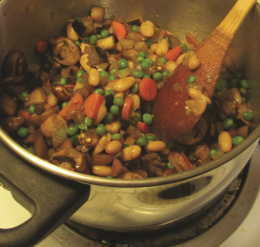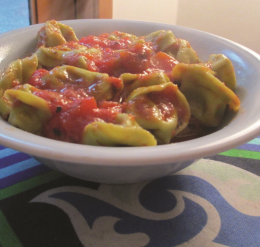Sometimes the best way to save on food is to make your own. Here are some basic and inexpensive recipes you can use to feed yourself and wow your friends.
Simple Rice
By Nikita Buley, Hoya Staff Writer
Rice is the perfect college food. It’s cheap, delicious, easy to make, easy to reheat and easy to add to a lot of other recipes. Eat it with eggs. Throw in some frozen vegetables for the last few minutes of cooking to instantly steam them and make your meal a little bit healthier. Or just douse it with butter, salt and pepper and go at it with a spoon.
While some people grow up eating this staple at practically every meal, cooking rice is an art and can be difficult for the uninitiated. Here’s a simple method to make deliciously fluffy and somehow creamy rice every time.
Ingredients:
1 cup rice
2 cups water
1/2 teaspoon salt
1/4 teaspoon pepper
1. Measure out the amount of rice you want into a big pot. The rice should fill — at most — only ¼ of the pot. One handful equals about one serving. (I like to make 2-3 servings at a time, since rice is so quick and easy to heat up later.)
2. Rinse the rice. Fill up the pot with warm water and rub rice between your hands under water. Refresh and repeat a few times.
3. Empty out the last batch of rinse water. Add clean water until it is as far above the rice as the rice is deep. (When you make rice, the ratio should be one part rice to two parts water. I usually eyeball it, but you can measure it out if that makes you more comfortable.)
4. Add salt. I usually put in about a half a teaspoon per serving.
5. Bring the rice to a full boil, then bring down to a simmer and cover with a lid. Cook until all water is gone and the rice is moist to taste. Add salt and pepper to taste.
Vegetarian Stir-Fry
By Sarah Kaplan, Hoya Staff Writer
All good things start with the rich, sweet smell of sauteed onions. If I’ve learned anything from being a vegetarian for more than three years, it is this.
Almost any cuisine can be made vegetarian, and almost any vegetarian dish can be as — if not more — satisfying as one with meat. But whatever you do, you’ll start with the onions.
From there, you can build the recipe in many different directions. In the mood for Mexican? Toss in garlic, diced bell peppers and carrots and a can each of corn, black beans and tomatoes. Add two tablespoons of cumin and a dash of cayenne pepper and you have chili. If Indian food is more your style, use mushrooms and a can of chickpeas instead of corn and beans, substitute curry powder for some of the cumin and add a can of coconut milk.
Lately, my go-to dinner has been a vaguely Thai twist on the above recipes, involving mushrooms, soy sauce and peanut butter. I won’t say it tastes just like Bangkok, but I’ve gotten more than a few jealous glances while eating it out of a Tupperware during my Culture and Politics seminar.
The tricks to these recipes and all vegetarian food are pretty simple. First, use beans. They’re super cheap and they’ll add heft to what is essentially a glorified salad. Second, spice liberally. Great spices can coerce even your least favorite vegetables into tasting amazing.
The last thing to remember is to have fun. The great thing about vegetarian cooking is that recipes are more general suggestions than hard and fast rules. The proportions are not too important, unlike in baking, and, because you’re not using meat, you’re not in any danger of accidentally poisoning your guests if you mess up. Feel free to experiment.
But whatever you do, don’t forget the onions.
ingredients:
1 medium yellow onion, diced
1 red bell pepper, diced
2 large carrots, diced
½ cup mushrooms, coarsely chopped
½ eggplant, diced in ½-inch cubes
1 cup frozen peas
1 can cannellini beans
¼ cup soy sauce
¼ cup orange juice
1 tablespoon smooth peanut butter
1 tablespoon fresh ginger, grated
Pinch of red pepper flakes
1. Sautee onion in about a tablespoon of olive oil in a large (I mean it — really large) saucepan over medium heat.
2. When the onions become translucent and begins to caramelize, add bell pepper, carrots, mushrooms and eggplant. Cook until eggplant begins to turn brown.
3. Pour soy sauce and orange juice into the pan. Add peas, beans, peanut butter, ginger and pepper flakes.
4. Allow the whole pan to simmer for about 10 to 15 minutes, until vegetables are cooked through and the sauce begins to thicken.
5. Serve hot over rice or noodles.
Marinara Sauce
By Victoria Edel, Hoya Staff Writer
My family has a pretty steadfast Sunday tradition: We buy fresh bagels after Mass, watch football and my mom puts up a pot of sauce. When I came to Georgetown, I was amazed by the number of people who thought that quality tomato sauce could be bought in a jar. Making a delicious marinara is both easy and cheap. Take a page out of my mom’s book and make more than you need; You can always freeze the leftovers to use when you want a quick dinner. The expensive part of this meal is buying the olive oil and dried herbs, but both are one-time investments that will last you through hundreds of pots of sauce. During every other trip to Safeway, you’ll only need to replenish your supply of tomatoes and garlic.
Some people may put sugar, onions or other sacrileges into their sauce — I’m looking at you, Ina Garten. Those people are fools. You want to keep this as simple as possible.
Once you’ve made your marinara, it can serves as a base for about a million delicious things. Use it to make chicken or eggplant parmigiana. (For the unordained, that just means it has sauce and mozzarella on top.) Buy some fancy tortellini or ravioli and throw sauce over it — it’s basic enough that it won’t be overpowering but delicious enough to dress up an otherwise simple dish of pasta. Fry up some sausage, if that’s your thing, and throw them into the pot of sauce to cook — just make sure you cut down on the salt. Or, go the simple route and boil a pound of rigatoni — my childhood favorite — cover it all in sauce and add a dollop of ricotta.
Whatever you choose, believe me: Once you make this, you’ll never buy Prego again.
Ingredients:
1 can crushed tomatoes
3 Tbsp. olive oil
3 cloves of garlic
1 Tbsp. dried oregano
1 Tbsp. dried parsley
1 lb pasta, your choice
1. Mince the garlic. Some people have issues peeling the cloves. Take a large knife, place it flat on top of the cloves and press down hard with the heel of your hand. This will break the peel open and make it a lot easier to get the clove out.
2. Heat the olive oil in a large pot over medium heat and add the garlic. Watch the garlic closely because it can burn easily. Give it a few stirs so it’s well mixed with the oil. This is my favorite step, because the smell is amazing, but it is also the point in the process at which everyone will realize what you’re doing and decide that they want pasta too.
3. Once the garlic is lightly golden, add the can of tomatoes. Be quick or the garlic will burn, and the whole thing will not turn out right. For every can of tomatoes you use, add one can-full of water.
4. Bring the sauce to a boil, and then add the salt, pepper, oregano and parsley. Stir the mixture, and then lower the heat and cover.
Toasted Coconut Chocolate Chewies
By Nikita Buley, Hoya Staff Writer
These cookies are gooey on the inside, crispy on the outside, oh-so-chocolately and deliciously full of coconut. Think of them as a rough approximation of the Girl Scouts’ hallmark Samoas. That they’re gluten free is an added bonus for those of us who can’t or choose not to eat gluten. An ideal college-kid recipe, they include a small number of relatively cheap ingredients, although they’re much easier to make if you have parchment paper and a mixer of some sort. You’ll also save money since you don’t have to buy flour or butter, which go into most recipes. They can, however, also easily be made vegan by substituting chia seeds for the eggs.
Recipe adapted slightly from Edible Perspectives
Makes 20-22 cookies
ingredients
3 cups sifted powdered sugar
1/2 cup unsweetened cocoa powder
(I used Ghirardelli dark chocolate because it happened to be cheapest.)
1/2 tsp. salt
2 cups sweetened, shredded coconut
1 Tbsp. vanilla
3 large egg whites
1. Preheat the oven to 350°F. Line two large baking sheets with parchment paper. If you don’t have parchment paper, butter the pans vigorously before baking cookies.
2. Toast coconut on an uncoated baking sheet for about five to six minutes, stirring every two minutes or so. Keep a close eye on it, as coconut burns very easily. When the coconut has developed a golden hue, set it aside to cool.
3. Sift together powdered sugar, cocoa powder and salt.
4. Add egg whites one at a time, and mix until batter is well-blended and smooth.
5. Add vanilla and mix on medium-high speed (or at maximum arm-muscle power) until the batter starts to thicken and small stiff folds form and remain in the dough as you mix. You will start to notice that it gets more difficult to mix.
6. Carefully fold in the toasted coconut.
7. Drop the batter by rounded tablespoons onto the prepared baking sheets. The cookies spread a bit, so make sure you leave about 2 inches between each one.
8. Bake cookies for 15 minutes. The cookies will look puffy, crack and have a dull sheen when done.
9. Let the cookies cool completely before removing from the pan so they won’t fall apart.









